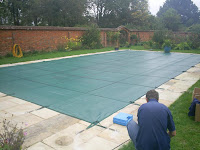So how often and what should I use as a media?
In a domestic application with the correct flow rate and filter area, sand should and will last 6-8 years, especially if it is periodically receives a deep chemical clean often done as a service at the start of a season by your local pool company.
The easiest way to identify if the filter media needs changing is by the visual effect of they water, the speed it clarifies any water issues or to actually inspect the sand for a smoothness
The media polishes the water, removing organics, oils and greases. The sharper the sand the greater its filtering capacity. However, through water movement the media will be smoothed and the sharpness of the sand diminished; think of a beach and smooth pebbles. The effect of this reduces the medias ability of removing fine debris and organics.
Well balanced and filtered pool water should shimmer and almost shine, if its appearance is dull then the chemistry could be unbalanced or the sand is struggling to remove the fine suspended debris.
The touch test is a good way of identifying this; by shinning a touch into the pool at night and identifying tiny particles suspended in the water is an indicator that the media needs changing. As a temporary solution a flocculant can be used, which assists the filter in gathering these fine particles. However with continued dullness then a change in media should be considered.
Domestic filters are either 18" 24" or 32" in diameter and will hold aprox 100kg 150kg or 200kg of normally a silica 16/30 sand. The larger filter may have a shingle at the bottom of the filter to support the sand from crushing the filtering laterals, 'fingers' in the bottom of the filter.
Removing a filter lid is never easy. Having the correct tool/spanner always makes it easier, although even then some gentle persuasion will be needed. To reduce the water content then the drain valve at the bottom of the filter should be released.
The only way to remove the sand through the tight hatches is by using a cup or better still a wet and dry vacuum, that will suck the sand out. Either way it is a laborious task.
Once removed the laterals should be checked for damage and wear. They should twist or unscrew. Don't hesitate to replace if you have any concern, there is nothing worse than needing to replace them the following year as sand starts to enter the pool through a damage lateral.
Once emptied then you can recharge the filter with either silica sand, Zeoclear or glass. With top mount filters it is recommended to block the central delivery pipe to prevent media entering the pipe.
Sand is the most popular media and has been used since the year 'dot.'
Glass is very effective but does wear quickly (not as hard as sand).
Zeoclear is an excellent media at breaking down ammonias and therefore reduces the regularity of backwashing. It also has the added advantage of being able to be rejenervated by a saline wash every 24months, therefore not needing to be changed after the 6-8years. However, Zeoclear is more expensive, although with a domestic filter this is only marginal, especially when spread over the years.
Once charged, replace the filter lid and perhaps use a silica grease on the o ring for an effective seal.
Heavily rinse the sand before you return to filtration to prevent the dust of the media returning to the pool.
Depending on the size of the filter the task should take 2-4hrs and would cost aprox £200-£400 if a pool specialist were to complete the task.



